Overview
Kelp forest decline is a severe global climate problem. In Northern California, more than 90% of kelp forests along 350 km of coastline were lost [1].
Satellite View Northern California kelp forest coverage. Image source: Meredith McPherson [5] | Underwater View An urchin barren in Monterey Bay, California. Photo source: Michael Langhans [6] |
Grazing purple sea urchins are destroying the kelp forests and preventing them from regrowing. 350 million purple sea urchins were found on one Oregon reef, a 10,000% increase since 2014 [2].
Present methods of culling purple sea urchins include the time-consuming task by divers to collect each urchin one by one and place them into a bag.
Diver collecting purple sea urchins by hand. Photo source: Sierra Rose Garcia [7]
Otter Force One detects and captures purple sea urchins to protect kelp forests.
The device can be used hands-on by divers or as a standalone autonomous benthic device.
By placing these devices around the perimeter of a kelp forest, ongoing protection can happen even without divers present.
Otter Force One detects the urchins using its camera and AI. It automatically pulses a jet of water to dislodge the urchin. Then activates suction to bring the urchin into a bag non-destructively. Data of the number of urchins per meter squared is recorded to monitor progress.
The core system is structured as follows:
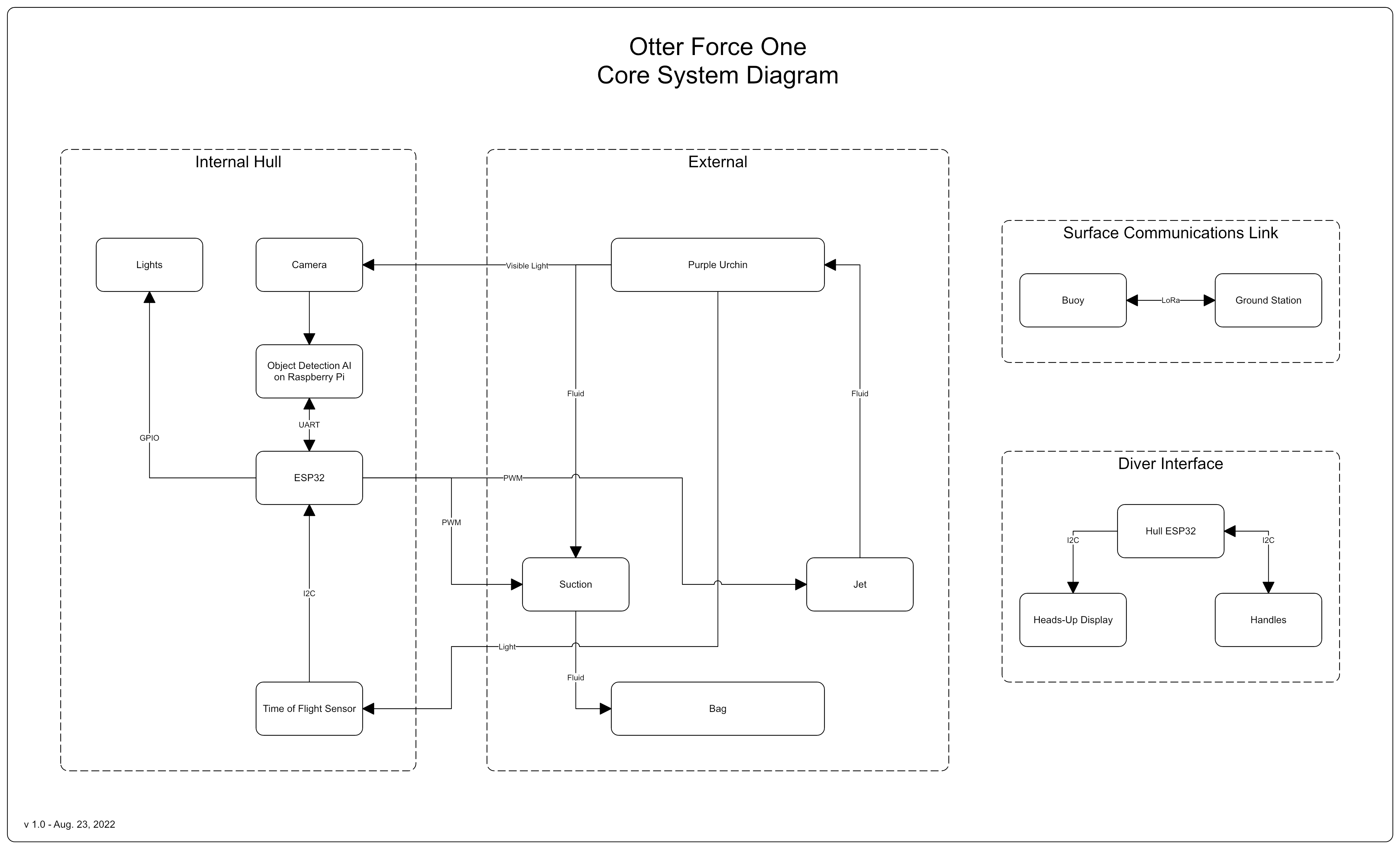
The primary hardware is located in the internal hull.
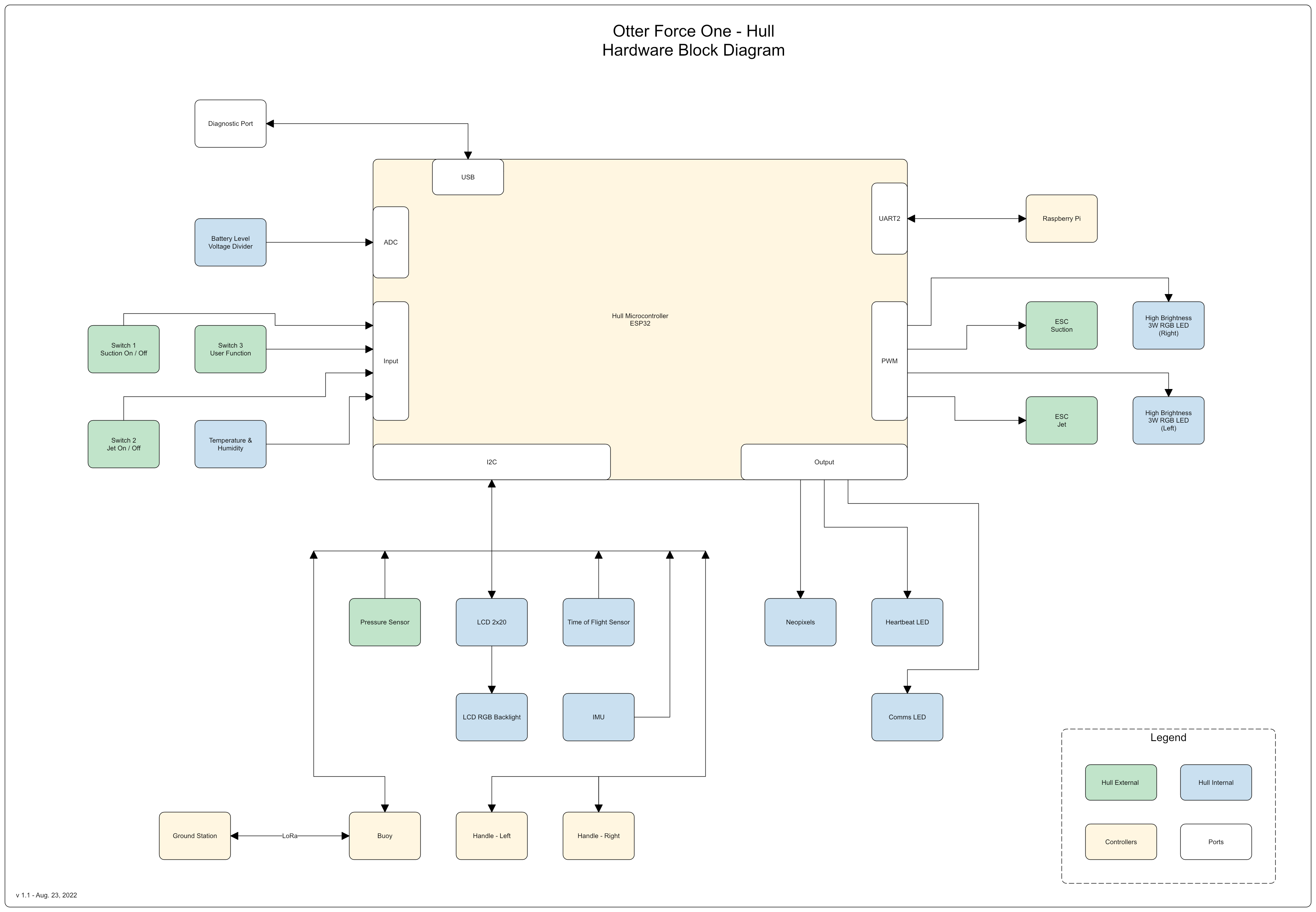
The device prototype measures 34 cm tall x 38 cm wide (50 cm with handles) x 68 cm long. Miniaturization would occur in the next iteration after proven functionality. The CAD model can be found in the Github repository here.

Human intervention is needed to restore the delicate balance between kelp forests, sea urchins, and otters. Otter Force One places this tool into the hands of divers to address this global climate related problem in their own local region.
Sea otter with a purple sea urchin in Monterey Bay, California. Photo source: Morgan Rector [9]
The grazing purple sea urchins offer little to no nutritional value to otters. Thus, otters are not eating them. Otters are an endangered species. It is a delicate balance, as the below infographic details:
A Delicate Balance. Infographic source: National Geographic [8]
The Otter Force One prototype is in active development for the Hackaday Prize 2022 to address this massive climate related problem.
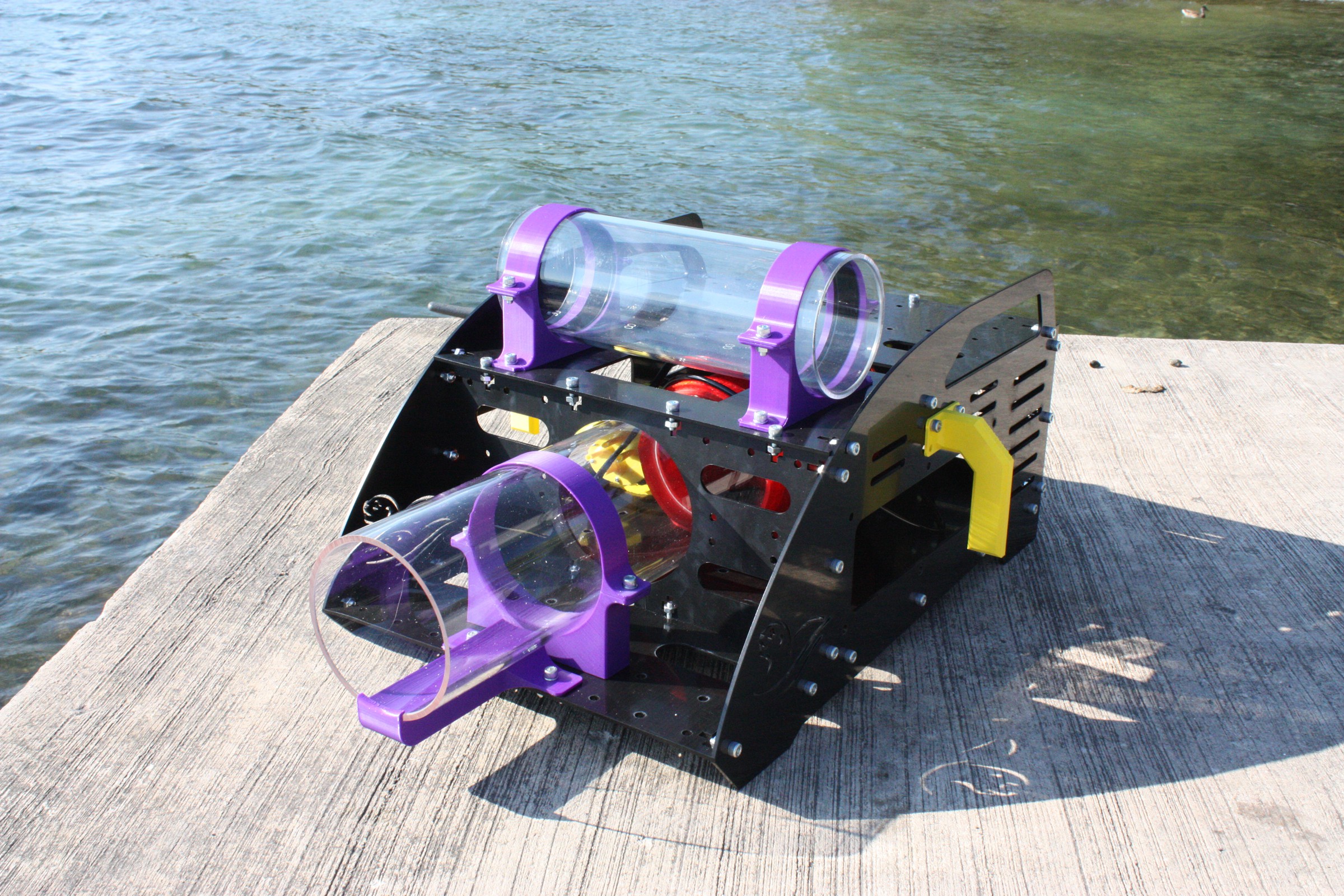
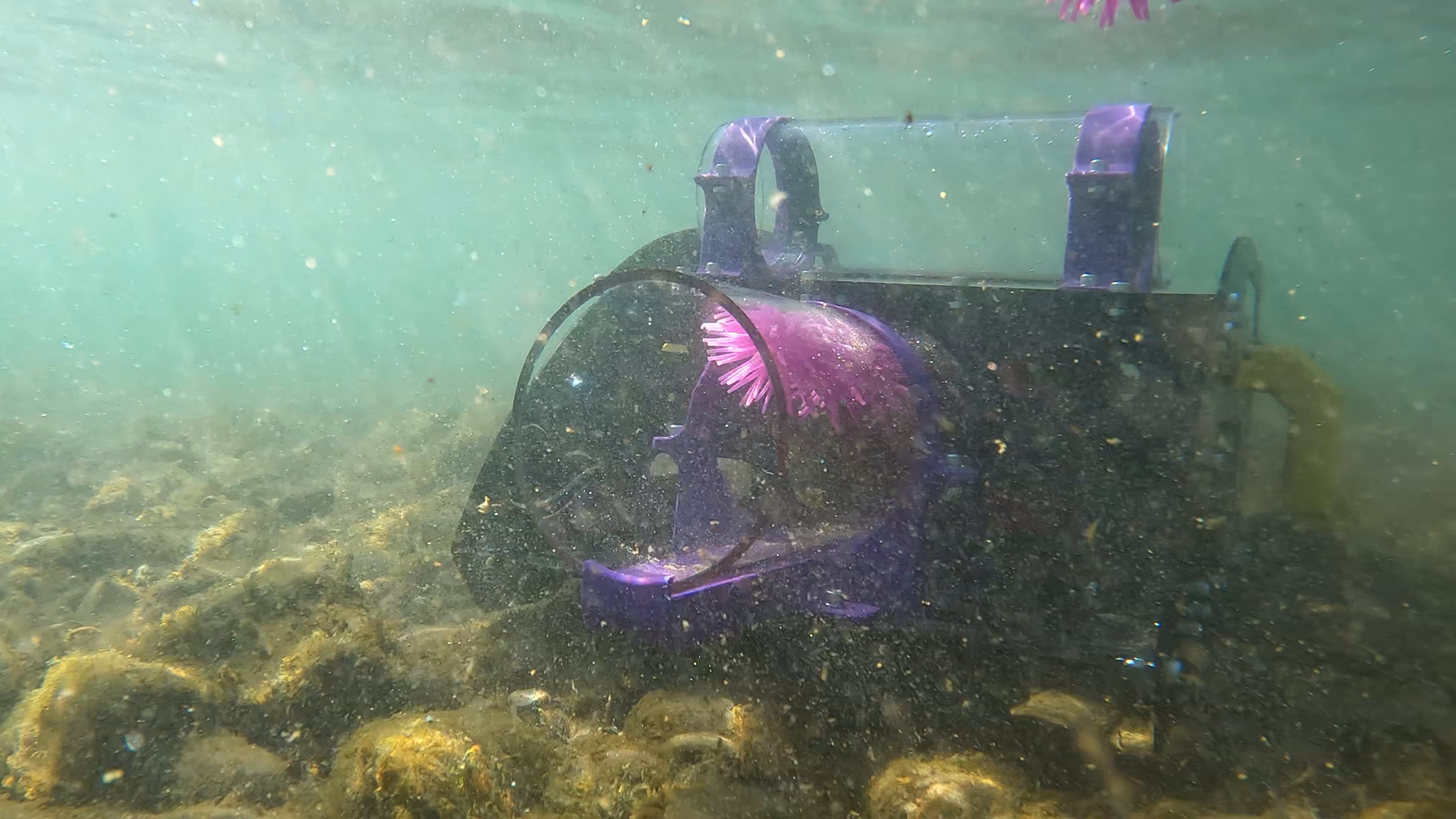
With the proper resources to further the prototype, solving the first step of the problem is possible. Join us on the journey to protect kelp forests with robotic collection and monitoring!
Let’s dive into more information in the following sections.
Development
Project logs table of contents
Problem
Kelp forest decline is a severe climate problem covering a large scale, magnitude, and speed [1]. More than 90% of kelp forests along 350 km of coastline in Northern California were lost [10]. With over 360 million acres of kelp forests around the world [11], the problem is global — Tasmania lost 95% of its giant kelp canopy [12].
Seaweeds (including kelp), store ~170 million tons of CO2 each year — thereby removing it from the atmosphere [13]. Kelp plays an important role in marine ecosystems by harbouring a greater variety and diversity of plants and animals than any other ocean community [14]. As well as protection for otters, which are apex predators of the marine nearshore environment [15]. Kelp forest loss is a climate driven catastrophe from multiple phases: loss of sea stars due to disease [16], a marine heat wave [17] which reduced marine oxygen levels [18], deforestation, and finally sea urchin barrens.
An urchin barren in Monterey Bay, California. Photo source: Michael Langhans [6]
Using satellite imagery, the decline in kelp canopy cover can be seen off the coast of Mendocino and Sonoma Counties in Northern California [5].
Image source: Meredith McPherson [5]
Historically, the kelp canopy in that region exceeded 50 km^2, in 2008. In 2014-2016, this area declined to < 2 km^2, as quantified through aerial surveys [1].
Source: [1]
Restoration
The first step in restoration is reducing the number of purple sea urchins.
In 2019, a kelp restoration plan along Sonoma and Mendocino coasts in Northern California gave commercial urchin removal a top-tier status. As recommended from a coalition of federal and state wildlife agencies, environmental nonprofits, tribes, and fishermen [19].
Historically, purple sea urchins were very low density in the subtidal regions, at 0.0 - 1.7 urchins / m^2 [1]. In 2018, the density is 9.2 - 24.1 urchins / m^2 [1].
There has been evidence that enabling kelp forests to grow back can be achieved when purple sea urchin densities are less than 2 urchins / m^2 [20].
Infographic source: [8]
Purple sea urchins are challenging. They can survive starvation conditions [5], they recolonize the areas so quickly that the forests can’t re-establish [20], and otters do not bother with smaller sea urchins as they do not have enough nutrients.
The way it used to work was that purple sea urchins would hide in the cracks and crevices, hiding away from the sea stars - which would be the predator. The urchins would eat kelp detritus, that is, pieces of kelp floating by. With the decline of sea stars, the urchins grew away from their usual hiding places [19].
Restoration efforts are conducted by divers who pick urchins one by one by hand. The urchins are stored into a crate or bag, which is then loaded onto the boat and transported back to shore.
Grant Downie loads a crate with purple urchins during a culling event in Fort Bragg, California. Photo source: Sierra Rose Garcia [7].
As a baseline, results from 17 divers can be seen for these commercial purple sea urchin harvesting efforts. This was an initiative from The Waterman’s Alliance funded through donations and grants in 2018.
Source: Sonoma-Mendocino Bull Kelp Recovery Plan [21]
Determining areas of interest for restoration is based on multiple factors, including ecosystem surveys and data [21]. This denotes the importance of sensor data that continuous monitoring could bring.
Solution
The goal is to resolve the purple sea urchin stage in the kelp forest restoration process.
Objectives:
- Speed up the hands-on efforts of divers to collect purple sea urchins
- Enable the autonomous collection of purple sea urchins when divers are not present
- Quantify the density of purple sea urchins to track progress
Recreational and commercial divers would use the device. Thereby, the solution must be low-effort to operate. It must not require expertise or competence in robotics. The goal would be to have divers trained on the system in 30 minutes. The user interface is similar to a sea-scooter.
Diver using a sea-scooter [22]
The goal will be achieved by getting the device into the hands of divers around the world where they can use it to increase the efficiency of their efforts, with quantifiable data on the progress. The existing network of diving schools and clubs can be leveraged to meet this goal.
Impact Benchmark
An individual diver averages collecting 100 urchins / hour. This serves as baseline data for our device to overcome. (Source: In the previous section, a table details the collected urchins per hour for 17 divers. The three numbers were divided by 17 and then averaged).
Costs
The target cost to manufacture the Otter Force One device (chassis, electronics, everything) is less than $750. This may change, especially considering being in the prototyping phase. The additional components of the system would increase the cost.
Otter Force One System
Application Description
Otter Force One can be operated hands-on by a diver, or as a standalone device.
The system is comprised of two main elements:
- Hull
- Device
The Hull houses the electronics. The device consists of the structure, suction tube, and thrusters.
The functionality is extended with the following elements:
- Diver Sensor Handles
- Buoy
- Ground Station
The Buoy enables communication from the Hull to the surface of the water, with the Ground Station on the boat receiving the data. The Diver Sensor Handles add safety features to the device.
Design Description
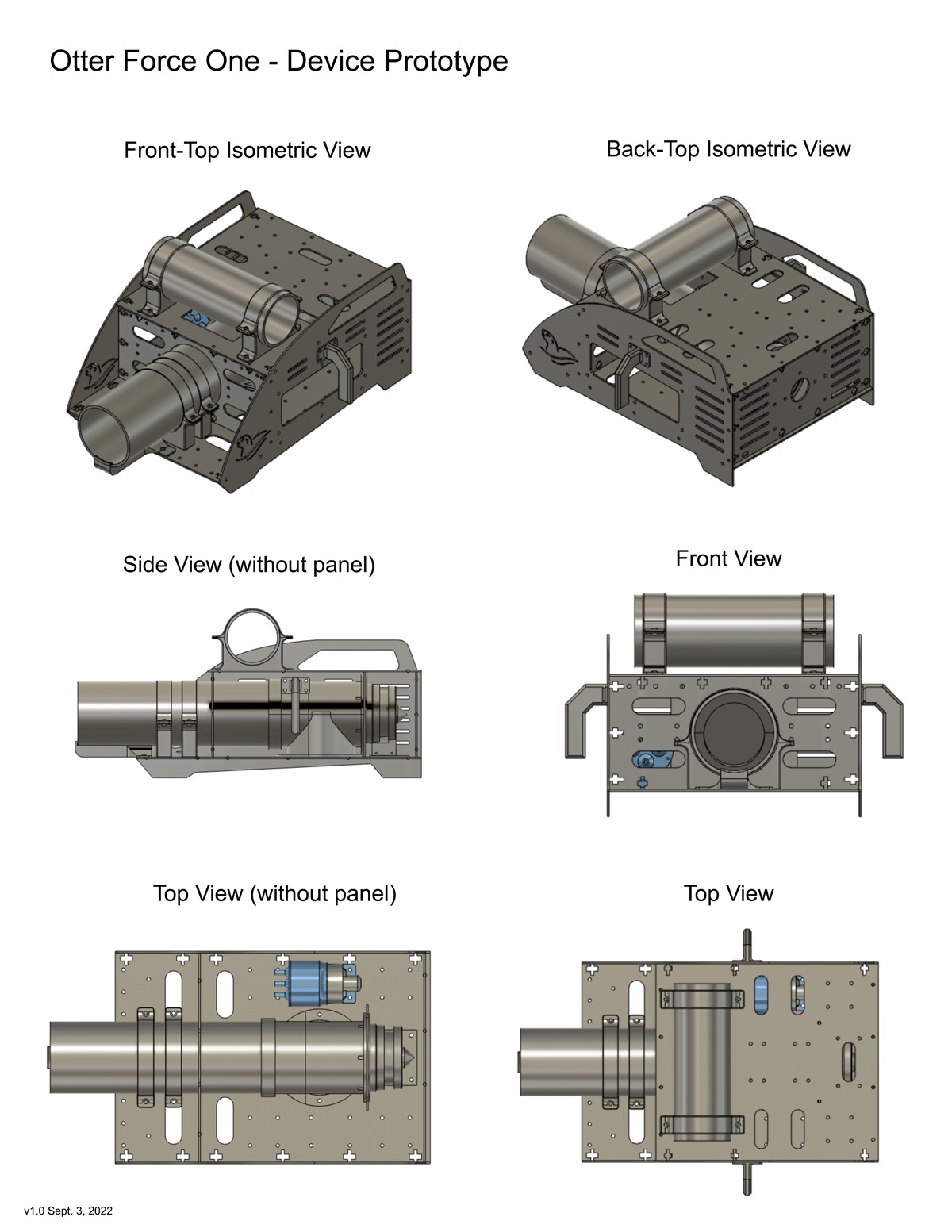
2D manufacturing for the chassis is chosen because of its scalability and variety of materials. Pieces that are 3D printed are designed with the geometry in mind to be one day injection moulded.
Hardware Description
Hull
The hull encloses a Raspberry Pi with a Pi camera to run object detection with a dataset trained on purple sea urchins. There is an ESP32 microcontroller which controls the outputs of the heads-up LCD for the diver, two 3W HB RGB LEDs for subject illumination, input buttons for manual overrides, and two ESCs. The two ESCs control the suction thruster and the pulse water jet thruster. The ESP32 and Raspberry Pi communicate over UART, and data is logged on the Pi with a timestamp from a RTC. Additional sensors include pressure sensor, IMU, and time of flight pointed at entry of the bag.
Power
The power source is a 4S rechargeable Lipo battery. This directly powers the two thrusters, which are BLDC motors. A switching regulator steps down the voltage to 5V for the Raspberry Pi and HB LEDs. A separate 3x 18650 battery is used to power the ESP32 and LCD via a PowerBoost 1000.
Buoy and Ground Station
Buoy circuit board with Ethernet - Image source: https://github.com/leonardoward/eja-intelligent-buoy-b-electronics
Otter Force One integrates into the open source Buoy and Ground Station developed by Leonardo Ward (https://leonardoward.github.io/). The work can be found on Github here (https://github.com/leonardoward/eja-intelligent-buoy-b-electronics), and it builds on the work from EJA [29].
The Hull connects to the Buoy through a tether using ethernet to work at extended distances.
Sensor Handles
The Diver Sensor Handles address the safety-critical aspect of divers operating the device. In 2018, a diver died when entangled in seaweed while harvesting purple sea urchins and not being able to contact for safety [28]. The Diver Sensor Handles are intended to be used in addition to existing safety measures such as visual contact, signal or audio device.
The handles have proximity sensors that are triggered only when the diver is holding on. This accomplishes two important safety-critical functions:
- Only activate when the diver is holding on
- Send a ping for help if the diver is not holding on for more than 2 minutes
The handles connect to the Hull, which then connects to the Buoy.
Software Description
(Coming soon)
Build Instructions
(Coming soon)
Debug Instructions
(Coming soon)
Economics
Image: A luxury restaurant dish of purple sea urchin - Umami Japanese Bistro. Photo by Chloe Enos [23]
The purple sea urchins that are collected have a market. As reported by the report “Markets for Sea Urchins: A Review of Global Supply and Markets”, Sardinia island, Italy, consumes 30 million sea urchins, equalling a gross value of $13.2 million USD. Their annual consumption is about four times that of Japan’s [24].
The loss of kelp forests has had a huge economic hit. In Northern California, the kelp forests supported fisheries for the red abalone, which was valued at $44 million USD per year [3].
Diving schools are prevalent globally [25]. This provides an ample distribution network to deliver educational workshops covering the use of our device [26].
The cost (per day or per hour) of divers and their availability varies significantly between countries. In Northern California, there has been mention of divers being paid $500 per day [27], however that does not include boat fees and permit fees.
Future Plans
The prototype is in active development for the Hackaday Prize 2022 to demonstrate the functionality required to address this massive climate related problem. The project started on July 24, 2022.
The next step will be to advance the prototype to conduct a pilot test in a conservation area.
To prepare the device for production, adding the electronic components onto a single circuit board would help to reduce manual assembly time, wire bulkiness, and increase reliability. Improving the design to use 2D fabrication methods will help to scale the manufacturability of the device and reduce the cost. The modifications to the design will be based on user feedback as mentioned above.
Best of all, the device will not be obsolete upon success — it can be repurposed for monitoring kelp, or repurposed for addressing invasive species such as zebra mussels.
Join us on the journey to protect kelp forests with robotic collection and monitoring!
References
[1] https://www.nature.com/articles/s41598-019-51114-y
[6] https://www.inverse.com/science/fate-of-kelp-forests-sea-urchin-study
[7] https://grist.org/climate/zombie-purple-urchin-california-kelp-forest-climate/
[8] https://education.nationalgeographic.org/resource/delicate-balance
[10] https://www.nature.com/articles/s41598-019-51114-y
[11] https://www.cnn.com/interactive/2021/07/saving-californias-kelp-forests-cte-spc/
[12] https://www.frontiersin.org/articles/10.3389/fmars.2020.00074
[13] https://www.nature.com/articles/ngeo2790
[14] https://sanctuaries.noaa.gov/visit/ecosystems/kelpdesc.html
[15] https://www.nps.gov/articles/deglaciationpredators.htm
[16] https://www.science.org/content/article/shocking-undersea-plague-obliterating-key-ocean-species
[17] https://www.earthdata.nasa.gov/learn/sensing-our-planet/blob
[18] https://www.frontiersin.org/articles/10.3389/fmicb.2020.610009/full
[19] https://baynature.org/article/bringing-back-kelp/
[21] https://farallones.org/wp-content/uploads/2019/06/Bull-Kelp-Recovery-Plan-2019.pdf
[23] https://www.225batonrouge.com/food-drink/look-rare-fresh-sea-urchin-prepared-umami-japanese-bistro
[24] https://urchinproject.com/2017/11/02/markets-sea-urchins-review-global-supply-markets/
[26] https://www.padi.com/courses
[29] https://hackaday.io/project/173457-2021-hdp-dream-team-eja
 EK
EK